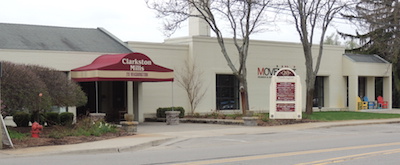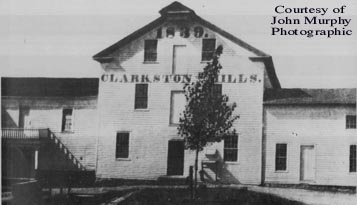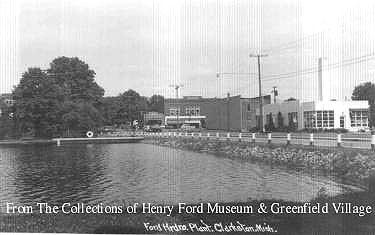
![]() Walking Tour-20 West Washington Street -Walking Tour
Walking Tour-20 West Washington Street -Walking Tour![]()
(South Side of Street)

![]() Walking Tour-20 West Washington Street -Walking Tour
Walking Tour-20 West Washington Street -Walking Tour![]()
(South Side of Street)
Butler Holcomb from Herkimer Co., N.Y. is credited with the purchase of 640 acres in Sections 20 and 21 of Independence Township bringing his family, wife and sons Daniel, 15, and William, 8, to settle on a portion of what is now called Clarkston in 1832. A year later Holcomb built a saw mill using the water power from the east branch of the Clinton river via a ditch approximately 1/2 mile long. Roswell/Roosevelt Holcomb was the "sawyer".
 Holcomb sold the property, milling privileges and water rights to brothers Nelson W. and Jeremiah Clark in 1838. The Clarks built a 200 foot long dam with a fall of 22' providing enough power for a 20' diameter overshot wheel. A 40' x 50' two- story grist mill with stone basement was completed by 1839. The mill was enlarged at least twice subsequently.
Holcomb sold the property, milling privileges and water rights to brothers Nelson W. and Jeremiah Clark in 1838. The Clarks built a 200 foot long dam with a fall of 22' providing enough power for a 20' diameter overshot wheel. A 40' x 50' two- story grist mill with stone basement was completed by 1839. The mill was enlarged at least twice subsequently.
An 1872 Map shows the foootprints of two separate buildings on the property at that time. One building faced the south side of West Washington St. while the other, larger building was at the end of Mill St. ( the passage which still exists between the 9 & 15 South Main Street buildings ). The alley, which runs from West Washington Street south to Depot Road to the east of the original Mill property ( now 20 W. Washington ), became a public way when Ford purchased the property and built the factory.
The Clarks sold the mill, by 1859, to E. S. Hirst and Co. The Hirst company ran saw, grist and plaster mills on the property. Henry T. Hirst succeeded Edward S. Hirst as the owner. Erastus Stiff became Henry T. Hirst's partner by 1872 when the map of the Village listed them as dealers in flour, feed, grain, plaster, salt and lime. In 1878 Stiff leased the property, for five hundred dollars a year, to William Holcomb, Butler Holcomb's son. William was listed in tax records by 1880 for land " west of the plaster mill race". John West held the eastern part of the property by 1881 ( this was H. T. Hirst's portion).
When John West died, Butler's brother, Charles, bought his half. A 1903 Pontiac Daily Press, article reads, "after changing hands several times ( the Clarkston Mill is ) now owned and operated by the Holcomb Brothers, grandsons of the man who built the mill." The brothers, Charles and Butler, made snowflake flour in the Clarkston Roller Mills. Butler had a carpentry shop, in one corner of the mill, producing boats, furniture and birdhouses. ( Some of the birdhouses may still be seen in the Village. ) In a 1/1/1932 article in the C. News, Butler recalled that the mill building was used for gatherings which were too large for the Opera Hall ( the second story of the Maccabbee building, 4 South Main St. ).
Tax records listed a series of names for the property from J. F. Deacon in 1914 ; Gibson in 1915 (Chelson Gibson, residence 104 N. Main, had a coalyard for a short time) ; Clarkston Roller Mills in 1917 ( the mill building was demolished in January 1917 ); and Denby in1918, until the property was purchased in 1920 from Frank R. and Maude G. Cook by Henry and Clara J. Ford.
 The property remained vacant until Ford proceeded with plans to build a small, water powered factory on the site as a part of his "Village Industries" program (in the interim their were discussions in the Village for various uses for the property, which included its use as a park.) The new factory was constructed in 1941 on the site of the old mill facing W. Washington St. In April of that year (after Russell Walter cut the last ice from the pond for his ice house business), the millpond height was lowered in preparation for construction. A temporary coffer dam failed (See Clarkston News 4/25/1941) draining the pond. In August while the pond bed was being cleaned a steam shovel slipped into the pond.
The property remained vacant until Ford proceeded with plans to build a small, water powered factory on the site as a part of his "Village Industries" program (in the interim their were discussions in the Village for various uses for the property, which included its use as a park.) The new factory was constructed in 1941 on the site of the old mill facing W. Washington St. In April of that year (after Russell Walter cut the last ice from the pond for his ice house business), the millpond height was lowered in preparation for construction. A temporary coffer dam failed (See Clarkston News 4/25/1941) draining the pond. In August while the pond bed was being cleaned a steam shovel slipped into the pond.
Subsequent additions expanded the building to include the site of the larger mill building which originally stood at the end of Mill Street, which ran west from South Main Street between 9 South Main and 15 South Main. Reportedly water power was never sufficient for the operation of the entire factory. The Ford Motor Company described the new factory as a part of "The Village Industries program, begun 25 years ago by Henry Ford is typified by this plant at Clarkston, Michigan. Most empoyees of the 18 Ford Village Industries live on small farms. Thus the Ford philosophy, 'one foot on the soil and the other in industry,' becomes an actuality."
Concurrently, Ford ran a Training School in the old Union School building, 90 N. Main Street. Power for that operation was provided by a generator installed in a new brick building constructed to the rear of the School building. Ford closed both the training school and the West Washington Street factory by 1945.
A Clarkston News article of 1948 reported a no vote on a $30,000.00 bond issue to finance the Village's purchase of the Ford Motor Co. Hydro Plant and approximately five acres on W. Washington and "running to Depot".
Beginning 1950 the Hawk Tool and Engineering Co. occupied the building, then the Nason Co. until it lay vacant for several years. In the late 1970s, developer Marc Alan remodeled the factory building creating a retail " boutique-style " mall with a restaurant in the basement. As retail operations dwindled a new owner converted much of the space to accommodate office use.
Official Property Description:
Significant Property History:
[A Synopsis Of Property Transfers Derived From Abstracts
(when available) And Periodic Changes In Ownership Or
Assessed Value Derived From Township Tax Records]